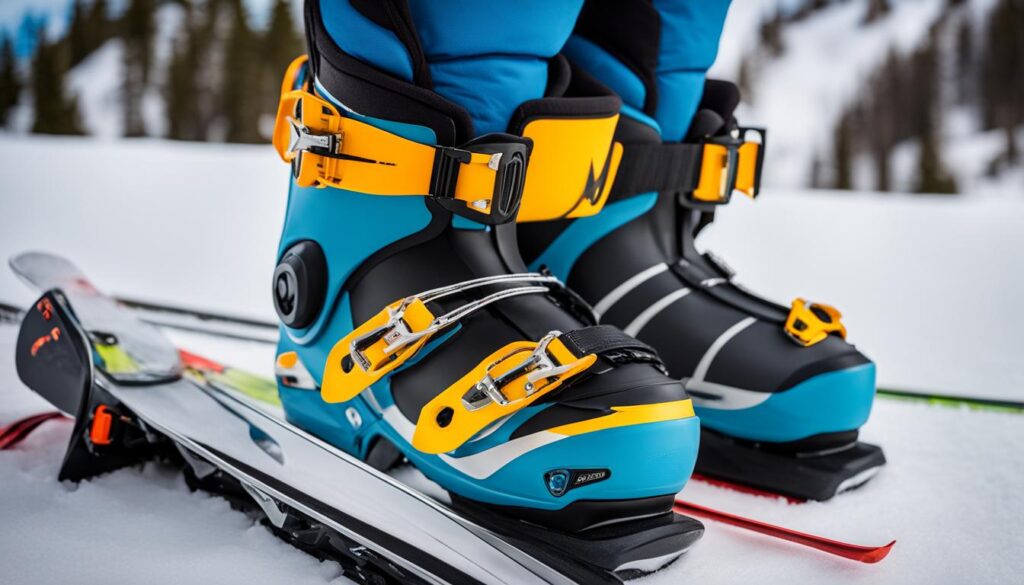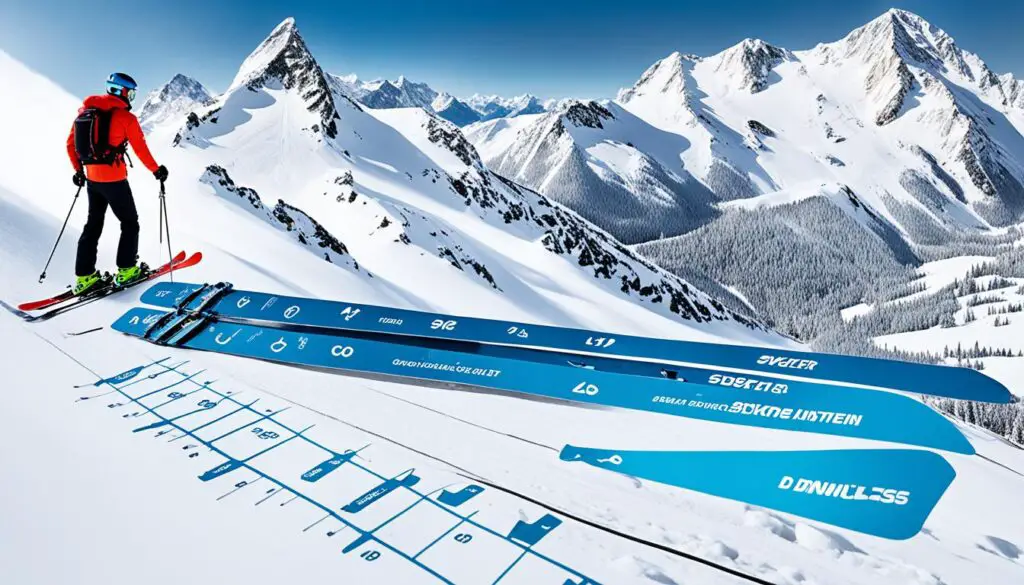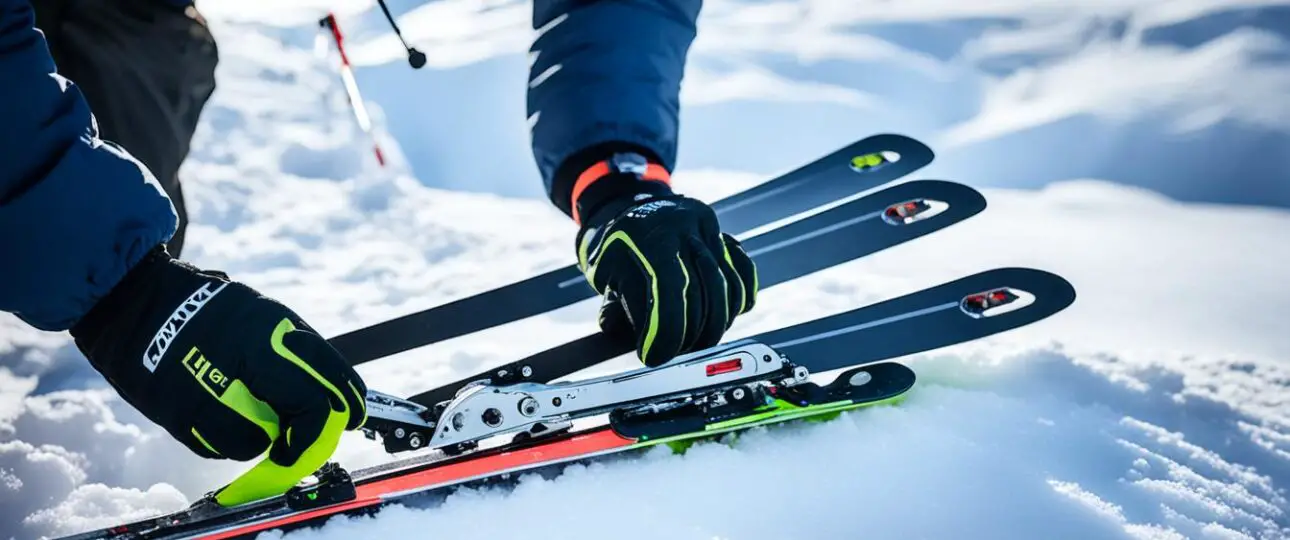Picture this: you’re standing at the top of a snow-covered mountain, the crisp winter air filling your lungs as you prepare to carve your way down the slope. As you push off, a rush of adrenaline surges through your body, and for a moment, you feel like you’re flying. It’s a feeling of pure freedom and exhilaration that only skiing can provide.
But amidst the excitement and thrill, there’s one crucial element that often goes unnoticed – your ski bindings. These seemingly small and inconspicuous components play a significant role in your skiing experience. They are the link between your boots and skis, providing control, stability, and ultimately, safety.
Properly adjusting your ski bindings is vital for your well-being on the mountain. It ensures that your boots are securely attached to your skis, preventing potential accidents and injuries. Whether you’re a seasoned skier or a novice hitting the slopes for the first time, taking the time to adjust your ski bindings is a must.
In this article, we will guide you through the process of adjusting your ski bindings. We’ll cover everything from determining your boot size to setting the DIN release correctly. By the end, you’ll have the knowledge and confidence to fine-tune your ski bindings for a safe and enjoyable skiing experience. So let’s dive in and discover the secrets of perfect ski binding adjustment.
Key Takeaways:
- Properly adjusting ski bindings ensures safety and stability on the slopes.
- Take the time to understand and follow the correct procedures for adjusting ski bindings.
- Consult a professional if you’re unsure or have any doubts about adjusting your own ski bindings.
- Boot length and DIN release setting are crucial factors in ski binding adjustment.
- Adjusting your own ski bindings can save you time and money, but knowledge and caution are important.
Can You Adjust Your Own Ski Bindings?
While ski shops and rental shops can adjust ski bindings for you, it is possible to adjust your own ski bindings with the right tools and knowledge. Adjusting your own ski bindings can save you time and money, but it is important to have a basic understanding of the process. By using a screwdriver and understanding the necessary information about the skier, such as shoe size and boot length, you can successfully adjust your ski bindings. However, it is always recommended to consult a professional if you are unsure or have any doubts about the adjustment process.
When it comes to ski binding maintenance and DIY ski binding adjustment, it’s important to keep safety in mind. While adjusting your own ski bindings can be convenient, it’s crucial to follow the manufacturer’s instructions and guidelines for your specific bindings. This ensures that the adjustments are made accurately and within the recommended parameters for your safety on the slopes.
Before attempting to adjust your ski bindings, gather the necessary tools, including a screwdriver that matches the size of the screw heads on your bindings. Having the right tools will make the adjustment process much easier and prevent any damage to the bindings or the ski equipment.
When adjusting your ski bindings, it’s essential to consider the correct shoe size and boot length. This information is crucial in setting the binding to ensure a proper fit and release in case of a fall or accident. A ski binding that is too loose can lead to premature release, affecting control and stability, while a binding that is too tight can result in inadequate release, leading to a higher risk of injury.
It’s also important to note that ski manufacturers usually provide detailed instructions or guides for adjusting their bindings. These instructions should be followed carefully to maintain the integrity and effectiveness of the bindings. Additionally, different bindings may have different adjustment mechanisms and procedures, so it’s crucial to refer to the specific brand and model instructions.
While adjusting your own ski bindings may seem manageable, it’s essential to have a baseline understanding of ski binding mechanics and safety requirements. Consider consulting a professional ski technician, especially if you are new to skiing or have any concerns about the adjustment process. They can provide expert advice and ensure that your bindings are adjusted correctly to optimize your skiing experience.
Ski binding maintenance and adjustment is an important aspect of ski equipment care. Regularly inspect your bindings for signs of wear or damage, such as loose screws, broken components, or excessive rust. If you notice any issues, it’s crucial to address them promptly and seek professional assistance if needed. Proper ski binding adjustment and maintenance contribute to a safer and more enjoyable skiing experience.
Remember, while adjusting your own ski bindings can be convenient, it’s important to prioritize safety and follow the manufacturer’s guidelines. When in doubt, seek professional assistance to ensure that your ski bindings are adjusted properly and maintained in optimal condition.
Pros and Cons of Adjusting Your Own Ski Bindings
| Pros | Cons |
|---|---|
| Save time and money | Risk of improper adjustment |
| Convenience | Lack of expertise and knowledge |
| Ability to fine-tune bindings to your preference | Potential safety hazards if not done correctly |
| Opportunity to learn and understand how bindings work | Void manufacturer warranty if adjustments are made incorrectly |
How to Adjust Ski Bindings for Your Shoe Size
When it comes to adjusting ski bindings, one of the crucial factors to consider is the length of your boots. This information can typically be found on the bottom or inside of your ski boot. Boot length is measured in millimeters and varies depending on the size of your feet. To ensure a proper fit, it’s essential to adjust your ski bindings to match your boot length.
Once you have determined the correct boot length, you can proceed with adjusting the ski bindings. Most ski bindings feature markers that indicate the boot size on the binding itself. By aligning these markers with the corresponding boot length, you can achieve the proper adjustment.
It’s important to note that the boot should fit securely in the binding without being too loose or too tight. A loose binding can affect your control and stability, while a binding that is too tight can lead to discomfort or even injury. Finding the right balance is key to a safe and enjoyable skiing experience.
Steps to Adjust Ski Bindings for Your Shoe Size:
- Locate the boot length information on your ski boot.
- Align the markers on the ski binding with the corresponding boot length.
- Ensure the boot fits securely in the binding without being too loose or too tight.
By following these steps, you can successfully adjust your ski bindings for your shoe size and optimize your performance on the slopes.

Adjusting ski bindings for your shoe size is just one aspect of achieving a proper ski binding setup. In the next section, we will explore the importance of setting the correct DIN release setting for your bindings based on factors such as weight, skiing ability, and boot length.
What Should Your Ski Bindings Be Set At?
When it comes to adjusting ski bindings, one critical factor to consider is the DIN release setting. The DIN release setting determines the amount of force required for the bindings to release your boots from the skis in the event of a fall. It is crucial to accurately calculate your DIN setting to ensure proper release and minimize the risk of injury.
The DIN release setting is determined by a combination of factors, including:
- Skier’s height
- Skier’s weight
- Ski boot length
- Skier’s skiing ability
To determine the appropriate DIN setting for your ski bindings, it is recommended to use a DIN calculator or consult a ski technician. These tools take into account the various factors and provide you with a recommended DIN setting. By setting your ski bindings to the appropriate DIN release, you can ensure that they will release when necessary, keeping you safe on the slopes.
Remember, setting your bindings too high may prevent them from releasing, increasing the risk of injury. On the other hand, setting them too low may cause premature release, resulting in a loss of control. Therefore, it is essential to follow the recommended DIN setting for optimal performance and safety.
“Properly setting your ski bindings according to your DIN release setting is crucial for your safety and performance on the slopes.” – Ski Expert
Here is an example of a DIN release setting table:
| Skier Type |  |
|---|---|
| Type I (Beginner) | 1-3 |
| Type II (Intermediate) | 3-7 |
| Type III (Advanced) | 7-12 |
| Type III+ (Expert) | 12+ |
It’s important to note that the values in the table are approximate and may vary based on individual factors. For a more accurate DIN release setting, consult a professional or use a DIN calculator specific to your ski bindings and boots.
Conclusion
Proper ski binding adjustment is crucial for a safe and enjoyable skiing experience. By taking the time to tune your ski bindings accurately, you can minimize the risk of injury and maximize your performance on the slopes. Whether you choose to adjust your own bindings or consult a professional, following the best practices for ski binding adjustment is essential.
First and foremost, consider the boot length when adjusting ski bindings. Ensure that the boot fits securely in the binding without being too loose or too tight. This will provide the necessary stability and control while skiing, preventing any accidental release or discomfort.
In addition to boot length, understanding the DIN release setting is vital. The DIN release setting determines the force required for the bindings to release in case of a fall. Calculating the appropriate DIN setting based on factors such as height, weight, and skiing ability will ensure proper release and minimize the risk of injury.
While adjusting your own ski bindings can be convenient, it is always recommended to consult a professional if you are unsure or have any doubts. Ski shops and technicians have the expertise and tools necessary to fine-tune your bindings accurately, giving you peace of mind on the mountain.
Remember, ski binding tuning and best practices for adjustment are key to a safe and enjoyable skiing experience. Take the time to adjust your bindings properly, and you’ll be able to ski with confidence, knowing that you have taken the necessary steps to optimize your performance and protect your safety.



